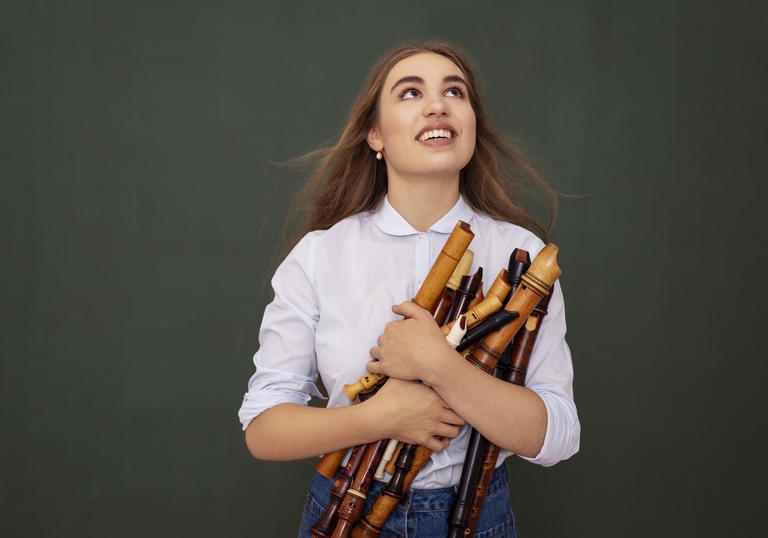‘And thence I to Drumbleby’s, and there…did buy a recorder, which I do intend to learn to play on, the sound of it being, of all sounds in the world, most pleasing to me...’
When Samuel Pepys made this entry in his diary, on 8th April 1668, the recorder was already long-established as an instrument capable of delighting amateurs and professionals alike. Its clarity, agility and sweet tone have carried it, fundamentally unchanged, through five centuries of music-making in public and at home.
Dario Castello seems to have been baptised in Venice in 1602; he might or might not have died in the Bubonic Plague pandemic of 1629-31. The information printed on the first edition of Castello’s first book of ‘Concertante sonatas in the modern style’ in 1621 tells us that he was ‘head [capo] of the company of musicians on wind instruments’ – and this short sonata is exactly as theatrical as you’d expect from the golden age of Venetian music.
In Tudor England, John Dowland cut an even more striking figure. ‘My trifles come as treasures from my mind’ he joked; but his music often told another tale – of an artist who described himself as Semper Dowland, semper dolens: ‘Always Dowland, always sorrowful’. The haunting lute song Flow My Tears (1596) began life as an instrumental pavane, and would inspire countless variations and imitations – including Benjamin Britten’s Lachrymae in 1950. The third of Stravinsky’s Three Pieces for solo clarinet – composed in 1919 as a ‘thank-you’ to the clarinet-playing millionaire who’d funded The Soldier’s Tale – is even more simple in its means. Like a Picasso doodle, a single line of music evokes limitless personality and potential.
Francois Couperin, meanwhile, wrote principally for keyboard, but with such colour and fantasy that miniatures often seem to cry out for other instruments. Le Rossignol en amour (The Nightingale in Love) comes from his 13th Ordre of keyboard pieces (1722) but Couperin admitted that ‘This “Rossignol” can be performed with the greatest possible success on the flute, when it is well played’. As for J S Bach – well, his prowess as an organist and keyboard virtuoso is remembered to this day, and contemporary sources agree that he was also a fine violinist. But was this universal musician also a lutenist? He certainly knew and worked with some skilled professional lute players.
We don’t know when, and why, Bach wrote his C minor Lute Suite. The earliest surviving manuscript dates from around 1741, when Bach was working in Leipzig – and reportedly experimenting with a lautenwerck: a new type of harspsichord specifically designed to imitate the sound of a lute. After a measured, improvisatory ‘Preludio’ echoing the so-called ‘style luthé’ (Lute style), Bach gives us an eloquent fugue, and two dances – a melancholy ‘Sarabande’ and a lilting ‘Gigue’ (with a rippling double).
No such speculation is necessary about Arteria (2021), by the Finnish composer Lotta Wennäkoski, written specifically for Lucie to be played on her European Concert Hall Organisations (ECHO) tour. In the composer’s words:
‘The starting point for the new piece is energy: the music combines constantly changing timbres with a pulsating beat. But I have also allowed some melodic outbursts - I know that a real virtuoso like Lucie will also breathe an amazing life into them.’
Caccini’s Non ha’l ciel contanti lumi (first published in Florence in 1614) returns us to Renaissance Italy – a love song, shot through with ardent yearning. Neither the stars in heaven nor the flowers of spring outnumber the sorrows of a lovelorn heart. The Korean composer Isang Yun knew a rather more real, and brutal, form of suffering: his political principles led to his abduction and imprisonment in the 1960s. ‘The Visitor to the Idyll’ – the first of his Chinese Pictures (1993) for solo recorder – fuses the soundworlds of Korean classical music and the postwar European avant-garde to create a classic of the contemporary recorder repertoire.
Anne Danican Philidor belonged to a dynasty of French musicians; his father was a virtuoso on the crumhorn and his brother was one of the 18th century’s greatest chess players. During his short life, Anne (in this context, a male Christian name) played at the court of Louis XIV and inherited his father’s way with woodwind instruments: this graceful four-movement sonata for flute à bec (recorder), with its fugal inner movements, was published at Versailles in 1712. Philidor must surely have known and worked with another of Louis’s court musicians – the fabled viola da gamba player Marin Marais, whose ‘science and beautiful execution’ (in the words of one contemporary) ‘distinguish him from all others, and make him justly admired by all who hear him’. Originally written in 1701 for Marais’s own instrument the Couplets sur Les Folies d’Espagne comprise ten far-ranging variations on the famous old Iberian melody La Folia – also used by Lully, Corelli, Vivaldi, Bach, Handel, and (in the 20th century) Sergei Rachmaninov.
© Richard Bratby

